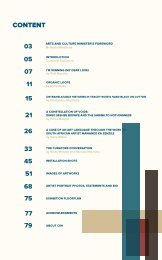The Stronger We Become Catalogue
Strength and resilience come into sharp view when a critically acclaimed collective of curators, Nkule Mabaso and Nomusa Makhubu rise alongside artists Dineo Seshee Bopape, Tracey Rose and Mawande Ka Zenzile to represent South Africa.
Strength and resilience come into sharp view when a critically acclaimed collective of curators, Nkule Mabaso and Nomusa Makhubu rise alongside artists Dineo Seshee Bopape, Tracey Rose and Mawande Ka Zenzile to represent South Africa.
Create successful ePaper yourself
Turn your PDF publications into a flip-book with our unique Google optimized e-Paper software.
Ka Zenzile’s work is therefore not necessarily about ‘visual art’ per say but rather the language of art, where visual<br />
references and language is placed within a particular context. This context, he seems to suggest, is stuck<br />
somewhere between challenging pedagogies and epistemologies and using the very same methodologies to<br />
subvert a way of seeing and thinking. As noted by wa Thiongo, ‘how we see a thing – even with our eyes – is very much<br />
dependent on where we stand in relationship to it’. 31 Ka Zenzile’s oeuvre thus becomes visual anecdotes that draw<br />
attention to how he is not only working with aesthetics, which he poignantly points out are part of how he grew up in<br />
formulating his own genealogy, background and memory. Ka Zenzile is not only creating an identity for himself through<br />
an artistic expression that points to how one does not only view themselves in their environment, but also much like wa<br />
Thiongo describes, through a way of questioning one’s perspective. His practice thus becomes an artistic language that<br />
does not only root itself in creating what wa Thiongo describes as ‘the quest for relevance’ but also intuitively drawing<br />
from imagery that are themselves relevant in the public domain. Relevance is an important currency in linking visual art<br />
to how socio-political conditions govern perspectives and how these are often conflicted by one’s relationship to a sense<br />
of selfhood. Wa Thiongo notes that ‘certainly the quest for relevance and for a correct perspective can only be<br />
understood and be meaningfully resolved within the context of the general struggle against imperialism’, which he<br />
further points out is not always easy to see in literature. 32 What wa Thiongo seems to be highlighting is a consciousness<br />
around pedagogies, those that determine the way in which we access the world and understand our place in it.<br />
correct perspective is even harder to see or suggest in terms of visual art, and especially within a gallery or museum<br />
space where art and viewing art is often presented through a Euro-centric lens. Ka Zenzile’s is certainly aware of a<br />
tension that exist in how his practice oscillates between the language of self-articulation and assertion and a deep<br />
awareness of how the self is pronounced through a relationship to the institutional structures that govern citizenship and<br />
nationhood in present society. As noted by Nkule Mabaso ‘to understand the psychological motivation of this present<br />
society one must unpack, as ka Zenzile does, the historical legacy that the current democratic politic denies, hides, and<br />
at will, forcefully represses’. 33 While his work may be read as confrontational, this is to be understood as intentional and<br />
deliberate precisely because it ‘draws from poignant historical and contemporary political moments occurring in world<br />
history’. 34 <strong>The</strong> process of engaging with his work is therefore not determined by its placement within a particular space<br />
i.e. a gallery but rather bold relationship to its context. Mabaso further explains how ‘by sweeping across history ka<br />
Zenzile tries to use his materials not just to define himself, but to challenge ideologies, stereotypes associated wit h<br />
being black by appealing to the viewer’s imagination and experience of the social’). 35<br />
Ka Zenzile like many other young artists living and working in an era where political ideology is not only competing with<br />
the affluence and influence of popular culture is in a process of articulating a particular voice of relevance that forms part<br />
of a lineage of artists that have carved out an artistic language uniquely informed by a sense of conscious selfhood.<br />
References<br />
Koloane, David. “<strong>The</strong> Identity Question: Focus on Black South African Expression,”<br />
Third Text: Critical Perspectives on Contemporary Art and Culture, vol 23 (1993):<br />
99 – 102.<br />
Koloane, David. “Art Criticism for whom?” In Deepwell, K. Art Criticism and Africa,<br />
Saffron Books: London, 1998.<br />
Mabaso, Nkule. “<strong>The</strong> Art of the Possible: Mawande ka Zenzile,” Artthrob .<br />
Available Online: https://artthrob.co.za/2015/05/16/the-art-of-the-possible/<br />
[Accessed 31 March 2019]. 2015.<br />
Tsotsi, <strong>The</strong>mba. “Archetypocalypse,” NKA: Journal of Contemporary African Art,<br />
No. 42 – 43 (2018): 298 -300.<br />
O’Toole, Sean. “Maybe if you made this video it would be more technically<br />
resolved!, Artthrob: Contemporary Art in South Africa, published 5/2/2014,<br />
Available Online:<br />
https://stevenson.info/sites/default/files/2013_sean_o%27toole_artthrob_2013.pdf,<br />
[Assessed 1 April 2019], 2013<br />
Wa Thiongo, Ngugi. Decolonising the Mind: <strong>The</strong> politics of language in African<br />
Literature. Heinemann: Portsmouth. 1986.<br />
31 Ibid, 88.<br />
32 Ibid<br />
33 Mabaso, <strong>The</strong> Art of the Possible: Mawande Ka Zenzile<br />
34 Ibid.<br />
35 Ibid.<br />
31




